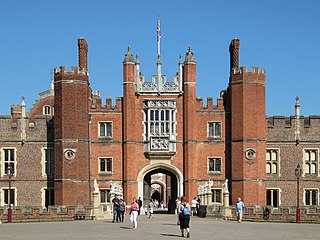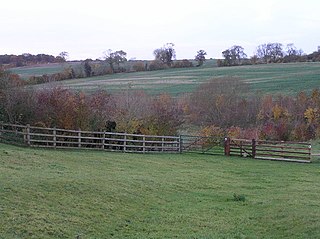
Catherine of Aragon was Queen of England from June 1509 until May 1533 as the first wife of King Henry VIII; she was previously Princess of Wales as the wife of Henry's elder brother, Arthur.

Jane Seymour, also known as Jane Semel, was Queen of England from 1536 to 1537 as the third wife of King Henry VIII. She succeeded Anne Boleyn as queen consort following the latter's execution in May 1536. She died of postnatal complications less than two weeks after the birth of her only child, a son who became King Edward VI. She was the only wife of the King to receive a queen's funeral, and his only consort to be buried beside him in St George's Chapel, Windsor Castle.

Anne of Cleves was queen consort of England from 6 January to 9 July 1540 as the fourth wife of King Henry VIII. Not much is known about Anne before 1527, when she became betrothed to Francis, Duke of Bar, son and heir of Antoine, Duke of Lorraine, although their marriage did not proceed. In March 1539, negotiations for Anne's marriage to Henry began, as Henry believed that he needed to form a political alliance with her brother, William, who was a leader of the Protestants of western Germany, to strengthen his position against potential attacks from Catholic France and the Holy Roman Empire.

Hampton Court Palace is a Grade I listed royal palace in the London Borough of Richmond upon Thames, 12 miles south west and upstream of central London on the River Thames. Building of the palace began in 1515 for Cardinal Thomas Wolsey, a favourite of King Henry VIII. In 1529, as Wolsey fell from favour, the cardinal gave the palace to the king to check his disgrace. The palace went on to become one of Henry's most favoured residences; soon after acquiring the property, he arranged for it to be enlarged so that it might more easily accommodate his sizeable retinue of courtiers. Along with St James' Palace, it is one of only two surviving palaces out of the many the king owned. The palace is currently in the possession of Queen Elizabeth II and the Crown.

Hatfield House is a country house set in a large park, the Great Park, on the eastern side of the town of Hatfield, Hertfordshire, England. The present Jacobean house, a leading example of the prodigy house, was built in 1611 by Robert Cecil, 1st Earl of Salisbury and Chief Minister to King James I, and has been the home of the Cecil family ever since. It is a prime example of Jacobean architecture. The estate includes extensive grounds and surviving parts of an earlier palace. The house, currently the home of Robert Gascoyne-Cecil, 7th Marquess of Salisbury, is open to the public.

Greenwich is an area of South East London, England, centred 5.5 miles (8.9 km) east-southeast of Charing Cross. It is within the Royal Borough of Greenwich, to which it lends its name. Historically it was in the county of Kent for hundreds of years, then the County of London from 1889 to 1965.

Margaret Douglas, Countess of Lennox, was the daughter of the Scottish queen dowager Margaret Tudor and her second husband Archibald Douglas, 6th Earl of Angus. In her youth she was high in the favour of her uncle, Henry VIII of England, but twice incurred the King's anger, first for her unauthorised engagement to Lord Thomas Howard, who died in the Tower of London in 1537 because of his misalliance with her, and again in 1540 for an affair with Thomas Howard's nephew Sir Charles Howard, the brother of Henry's wife Catherine Howard. On 6 July 1544, she married Matthew Stewart, 4th Earl of Lennox, one of Scotland's leading noblemen. Her son Henry Stuart, Lord Darnley, married Mary, Queen of Scots, and was the father of James VI and I.

The Palace of Beaulieu is a former Royal Palace in Boreham, Essex, England, north-east of Chelmsford. The surviving part is a Grade I listed building. The property is currently occupied by New Hall School.

Greenwich Park is a former hunting park in Greenwich and one of the largest single green spaces in south-east London. One of the Royal Parks of London, and the first to be enclosed, it covers 74 hectares, and is part of the Greenwich World Heritage Site. It commands fine views over the River Thames, the Isle of Dogs and the City of London.

Queen's House is a former royal residence built between 1616 and 1635 in Greenwich, a few miles down-river from the then City of London and now a London Borough. Its architect was Inigo Jones, for whom it was a crucial early commission, for Anne of Denmark, the queen of King James I. Queen's House is one of the most important buildings in British architectural history, being the first consciously classical building to have been constructed in the country. It was Jones's first major commission after returning from his 1613–1615 grand tour of Roman, Renaissance, and Palladian architecture in Italy.

The Palace of Placentia, also known as Greenwich Palace, was an English royal residence that was initially built by Humphrey, Duke of Gloucester, in 1443. It was located at Greenwich on the bank of the River Thames, downstream from London. The original residence was extensively rebuilt around 1500 by Henry VII. In 1660, it was demolished by Charles II to make way for a proposed new palace, which was never constructed. Nearly forty years later, the Greenwich Hospital was built on the site.

St James's Palace is the most senior royal palace in the United Kingdom. It gives the name, Court of St James's, to the monarch's royal court and is located in the City of Westminster in London. Although no longer the principal residence of the monarch, it is the ceremonial meeting place of the Accession Council, the office of the Marshal of the Diplomatic Corps, and the London residence of several minor members of the royal family.

Richmond Palace was a royal residence on the River Thames in England which stood in the sixteenth and seventeenth centuries. Situated in what was then rural Surrey, it lay upstream and on the opposite bank from the Palace of Westminster, which was located nine miles (14 km) to the north-east. It was erected about 1501 by Henry VII of England, formerly known as the Earl of Richmond, in honour of which the manor of Sheen had recently been renamed "Richmond". Richmond Palace therefore replaced Shene Palace, the latter palace being itself built on the site of an earlier manor house which had been appropriated by Edward I in 1299 and which was subsequently used by his next three direct descendants before it fell into disrepair.

The Old Royal Naval College is the architectural centrepiece of Maritime Greenwich, a World Heritage Site in Greenwich, London, described by the United Nations Educational, Scientific and Cultural Organisation (UNESCO) as being of "outstanding universal value" and reckoned to be the "finest and most dramatically sited architectural and landscape ensemble in the British Isles". The site is managed by the Greenwich Foundation for the Old Royal Naval College, set up in July 1998 as a registered charity to "look after these magnificent buildings and their grounds for the benefit of the nation". The grounds and some of its buildings are open to visitors. The buildings were originally constructed to serve as the Royal Hospital for Seamen at Greenwich, now generally known as Greenwich Hospital, which was designed by Christopher Wren, and built between 1696 and 1712. The hospital closed in 1869. Between 1873 and 1998 it was the Royal Naval College, Greenwich.

New Palace Yard is a yard northwest of the Palace of Westminster in Westminster, London, England. It is part of the grounds not open to the public. However, it can be viewed from the two adjoining streets, as a result of Edward Middleton Barry, who also assisted with its landscaping, having used railings rather than walls or fencing in its design. The yard has existed since about the year 1100, but was greatly reduced in the 18th century to allow for the construction of new streets and buildings, the most notable of which is the wing taking up the eastern end and having the most prominent tower of the current palace. Speaker's Green fronts the Thames. An underground car park used by Members of Parliament is beneath. Before latest incarnations of the palace, the yard was an open public space used diversely such as for speeches, tournaments, pilloryings, and executions. It has twice been the scene of terrorist attacks.

Mary Boleyn, also known as Lady Mary, was the sister of English queen consort Anne Boleyn, whose family enjoyed considerable influence during the reign of King Henry VIII.
Elizabeth Norton is a British historian specialising in the queens of England and the Tudor period. She obtained a Master of Arts in archaeology and anthropology from the University of Cambridge, being awarded a Double First Class degree, and a master's degree in European archaeology from the University of Oxford. She is the author of thirteen non-fiction books.

The Mistresses of Henry VIII included many notable women between 1509 and 1536. They have been the subject of biographies, novels and films.

Robin Hood's Larder was a veteran tree in Sherwood Forest that measured 24 feet (7.3 m) in circumference. The tree had long been hollow and is reputed to have been used by the legendary outlaw Robin Hood and others as a larder for poached meat. It was badly burnt by fire in the late 19th century and again in 1913. The tree fell in a gale in 1961 and no trace of it remains.

The Queen's Oak was a tree located near Potterspury in Northamptonshire. It is traditionally the site of the first meeting between Elizabeth Woodville and her future husband, Edward IV. The tree was badly burnt in 1994 and died in 1997.


















